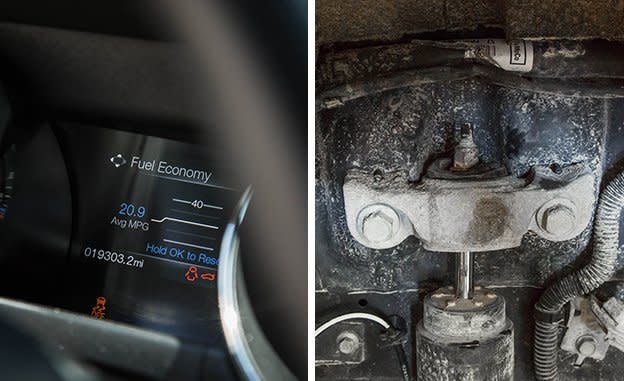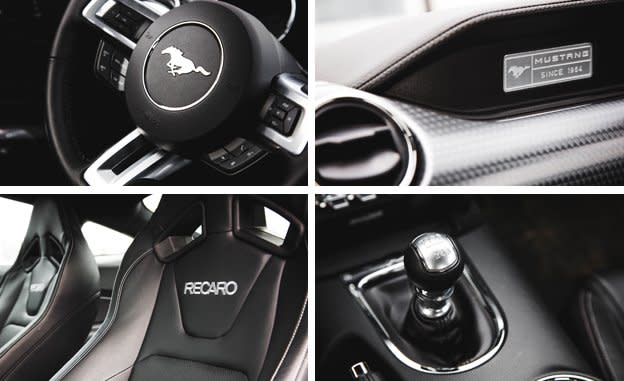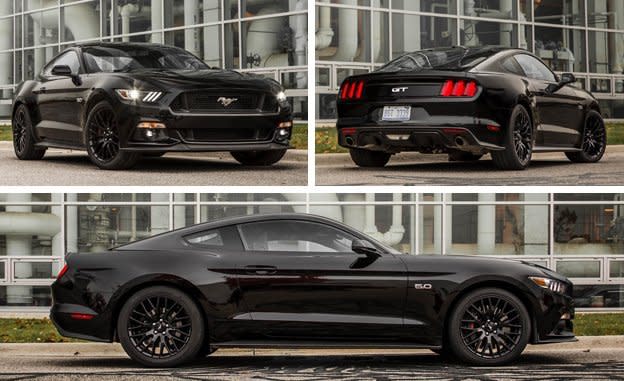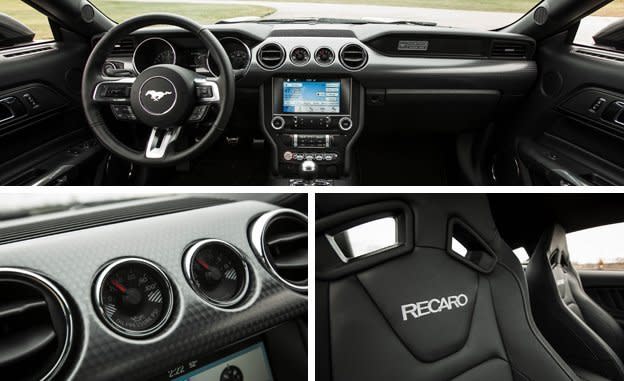2016 Ford Mustang GT Coupe

WHAT WE LIKE: Approaching the midway point of our long-term Ford Mustang’s 40,000-mile review, the 2016 GT continues to largely please drivers with its rev-happy, 435-hp 5.0-liter V-8 and sinister, blacked-out mien. Its Bridgestone Blizzak winter tires are long gone, and the return of 0.94 g of lateral grip from the Pirelli P Zero summer rubber means we’re back to tearing up country roads and highway interchanges. Despite its more civilized, global design, the latest Mustang still feels all-American at heart, including one of our favorite characteristics, the sloping fastback roofline that evokes that of the first-generation Mustang from the mid-1960s. It is an excellent way to get an instant pick-me-up. Additional long-distance travel also has boosted our average fuel economy to 20 mpg, which is 1 mpg better than the EPA’s combined rating and sufficient for 320 miles of range on the open road.
WHAT WE DON’T LIKE: The arrival of our long-term 2016 Chevrolet Camaro SS, however, has brought with it an alternative pony-car lens through which to view the Mustang. The Chevy’s wicked dual-mode exhaust makes us wish even more that we could hear the full voice of the Ford’s heavily muffled Coyote V-8. Both cars have comically small back seats, but our Mustang’s front chairs continue to elicit gripes about their confining side bolsters, which can impede smooth shifting of the six-speed manual transmission. Logbook comments have called out the GT’s brakes for being too grabby on initial application, particularly when they’re cold. And while Ford’s new Sync 3 infotainment system is vastly simpler to use than was the previous MyFord Touch, it’s a little too basic for some after exposure to the Chevy MyLink system in our better-equipped 2LT Camaro. The Mustang’s greatest demerit has centered on its manual shifter, which can often feel notchy in lower gears. It’s not helped by the short 3.73:1 gearing of our GT’s optional Performance package; several drivers have found it difficult to smoothly and quickly work through the lower ratios around town, where clunks from the drivetrain can be heard as each gear is selected. Our local Ford dealer inspected the shifter and the gearbox for problems but deemed it to be working normally.

WHAT WENT WRONG: Aside from lingering suspicions regarding the shifter’s well-being and a scheduled dealer visit for its 20,000-mile service ($82.85 for an oil and filter change, inspection, tire rotation, and a new cabin air filter), our Mustang’s largest issue since our last update has been Michigan’s apocalyptic roads. Specifically, a large pothole attempted to swallow the left-rear tire on our commute. The damage was severe, with the impact driving the shock-absorber shaft up through the shock and its upper mount and even denting the fuel-filler tube above that. We limped the GT to the dealer to have all those damaged components replaced and the suspension realigned. (Surprisingly, all four wheels and tires survived.) Repairs took less than a week, after which the dealer relieved us of $732.32.
WHERE WE WENT: While our long-termer is still primarily a commuter within southeastern Michigan, in the past 10,000 miles it has made treks to Ohio, Indiana, and Kentucky. Its latest voyage was to Virginia International Raceway to support our annual Lightning Lap track fest, at the conclusion of which road-test editor Chris Benn contemplated trading with another editor to drive the long-term Camaro SS back to Ann Arbor instead of the Mustang. Despite the shifter and the funky Recaros, he ultimately decided the GT was the more comfortable travel companion for the long trip home, proving that many of us still have lots of love for Ford’s latest pony car.
Months in Fleet: 8 months Current Mileage: 19,092 miles
Average Fuel Economy: 20 mpg Fuel Tank Size: 16.0 gal Fuel Range: 320 miles Service: $125.25 Normal Wear: $0 Repair: $0 Damage and Destruction: $732.32
Specifications >
VEHICLE TYPE: front-engine, rear-wheel-drive, 4-passenger, 2-door coupe
PRICE AS TESTED: $41,290 (base price: $33,295)
ENGINE TYPE: DOHC 32-valve V-8, aluminum block and heads, port fuel injection
Displacement: 302 cu in, 4951 cc
Power: 435 hp @ 6500 rpm
Torque: 400 lb-ft @ 4250 rpm
TRANSMISSION: 6-speed manual
DIMENSIONS:
Wheelbase: 107.1 in
Length: 188.3 in
Width: 75.4 in Height: 54.4 in
Passenger volume: 87 cu ft
Cargo volume: 14 cu ft
Curb weight: 3782 lb
PERFORMANCE: NEW
Zero to 60 mph: 4.3 sec
Zero to 100 mph: 10.3 sec
Zero to 130 mph: 18.0 sec
Zero to 150 mph: 25.4 sec
Rolling start, 5–60 mph: 4.9 sec
Top gear, 30–50 mph: 9.3 sec
Top gear, 50–70 mph: 8.8 sec
Standing ¼-mile: 12.9 sec @ 112 mph
Braking, 70–0 mph: 156 ft
Roadholding, 300-ft-dia skidpad: 0.94 g
FUEL ECONOMY:
EPA city/highway driving: 15/25 mpg
C/D observed: 20 mpg
Unscheduled oil additions: 1 qt
WARRANTY:
3 years/36,000 miles bumper to bumper;
5 years/60,000 miles powertrain;
5 years/unlimited miles corrosion protection;
5 years/60,000 miles roadside assistance
WHAT WE LIKE: We’ve gone nearly 8000 miles since our first report on this long-term test of the 2016 Ford Mustang GT and have grown much more comfortable with the latest pony car’s redesign and greater level of refinement. Our coupe has acquitted itself well as a reliable commuter vehicle in all types of weather. And even with the optional Recaro sport seats and the short, 3.73:1 final-gear ratio included in our test car’s Performance package, long-distance comfort has been impressive for front-seat occupants. Several longer highway journeys have helped our GT’s average fuel economy rise to 19 mpg, the same as the EPA’s combined rating. We’re still delighted with the 5.0-liter Coyote V-8’s 435 horsepower and burbly exhaust, as well as the continued compliments we receive for the car’s menacing, blacked-out appearance. The new Sync 3 system in the Mustang is a huge improvement over the previous MyFord Touch interface that we had so many issues with over the years. Its large, bright graphics, simpler menus, and greater connectivity make it much easier to use.
WHAT WE DON’T LIKE: Few drivers have complained about the new Mustang’s qualities, aside from not being able to enjoy the car more due to winter weather and the necessary fitment of Bridgestone Blizzak LM-32 winter tires. Although ultra-supportive, the Recaro seats have drawn the loudest gripes, perhaps also because of the climate near our HQ: The seats lack heating elements and their thick side bolsters can limit movement, particularly when shifting the six-speed manual while wearing a bulky coat. That said, the thrones have excellent lumbar support and even our largest front passengers have praised their comfort over long hauls. Despite our GT’s average range creeping up to more than 300 miles on a tank, it’s still incredibly easy to drain the Mustang’s 16-gallon supply in city driving. Other minor quibbles center around cabin ergonomics, such as the engine ignition button on the console being too easy to hit by accident (yes, that happened). The map pockets extend deep into the door panels, which is great until you lose track of an item and can’t see it hiding down there.

WHAT WENT WRONG: Aside from the V-8 needing a top-up with a quart of synthetic oil at 4100 miles, zilch. The Mustang has shrugged off Michigan’s cratered roads with ease, and its first service—a scheduled 10,000-mile job—included an oil-and-filter change and inspection for a mere $42.
WHERE WE WENT: Due to its short range and mostly useless back seat, the majority of our long termer’s travel has been confined to schlepping around metro Detroit as a commuter. Its longer treks have taken it to Indiana, Chicago, and Frankenmuth in central Michigan, with the latter two trips testing the Mustang’s winter mettle as it capably handled whiteout snow squalls and icy roads with little issue. As the weather gets warmer, the Mustang is likely to travel farther afield.

Months in Fleet: 5 months Current Mileage: 10,243 miles
Average Fuel Economy: 19 mpg Fuel Tank Size: 16.0 gal Fuel Range: 305 miles
Service: $42 Normal Wear: $0 Repair: $0
Damage and Destruction: $0
Specifications >
VEHICLE TYPE: front-engine, rear-wheel-drive, 4-passenger, 2-door coupe
PRICE AS TESTED: $41,290 (base price: $33,295)
ENGINE TYPE: DOHC 32-valve V-8, aluminum block and heads, port fuel injection
Displacement: 302 cu in, 4951 cc
Power: 435 hp @ 6500 rpm
Torque: 400 lb-ft @ 4250 rpm
TRANSMISSION: 6-speed manual
DIMENSIONS:
Wheelbase: 107.1 in
Length: 188.3 in
Width: 75.4 in Height: 54.4 in
Passenger volume: 87 cu ft
Cargo volume: 14 cu ft
Curb weight: 3782 lb
PERFORMANCE: NEW
Zero to 60 mph: 4.3 sec
Zero to 100 mph: 10.3 sec
Zero to 130 mph: 18.0 sec
Zero to 150 mph: 25.4 sec
Rolling start, 5–60 mph: 4.9 sec
Top gear, 30–50 mph: 9.3 sec
Top gear, 50–70 mph: 8.8 sec
Standing ¼-mile: 12.9 sec @ 112 mph
Braking, 70–0 mph: 156 ft
Roadholding, 300-ft-dia skidpad: 0.94 g
FUEL ECONOMY:
EPA city/highway driving: 15/25 mpg
C/D observed: 19 mpg
Unscheduled oil additions: 1 qt
WARRANTY:
3 years/36,000 miles bumper to bumper;
5 years/60,000 miles powertrain;
5 years/unlimited miles corrosion protection;
5 years/60,000 miles roadside assistance
Detroit’s muscle cars have experienced a renaissance of sorts lately—Hellcats, Shelbys, and Camaros, oh my!—yet it took some European-inspired refinement to bring the most out of Dearborn’s Ford Mustang. Heavily updated for 2015, which included the mainstream models’ first-ever independent rear suspension, the latest Mustang GT snagged a 10Best Cars award upon its debut and then bested the Dodge Challenger R/T Scat Pack and previous-gen Chevrolet Camaro SS 1LE in its first comparison test. Now we welcome this sinister-looking 2016 GT coupe into our paddock for a 40,000-mile shakedown.
The latest Mustang is an altogether more sophisticated thing than its predecessors, which is key for its new global mission. The ride is more comfortable and composed with the multilink rear suspension, which itself dictated a new tuning approach for the front strut setup. And the interior is more insulated and better turned-out, even if the fast rear glass means back-seat occupants will need to remove their heads before entering. Additional electronic aids, including adaptive cruise control and blind-spot warning, are now available, as is a 2.3-liter EcoBoost turbocharged four-cylinder. The car’s proportions are softer and more flowing than before, and the styling adopts much of Ford’s corporate look while still recalling Mustangs past. Updates for 2016 are limited to the addition of Ford’s much-improved Sync 3 infotainment tech on Premium models, along with secondary—and nearly invisible—turn signals integrated into the GT’s hood vents.

You can read our official breakdown of the 2016 Mustang here, as well as an in-depth interview with Ford’s development team here. But the most important thing about our test car is what makes it a GT: the 5.0-liter Coyote V-8, which develops a throaty 435 horsepower and 400 lb-ft of torque, up from the previous-generation GT’s 420 and 390. It’s not as wicked as the new Shelby GT350’s 5.2-liter flat-crank V-8, but the Coyote loves to rev and is an absolute hoot when paired with the standard six-speed manual gearbox, which is light in effort and snicks tightly through the gates. Performance figures from our test car’s initial visit to the track (after its break-in period) were strong and slightly quicker than our long-term 2013 Mustang GT’s, with a zero-to-60-mph time of 4.3 seconds and a quarter-mile pass of 12.9 at 112 mph.
Pricing a Pony
While base GT fastbacks start at $33,295, our Premium coupe in Shadow Black stickered at $37,295 before options and features a host of trim and equipment upgrades: brighter interior accents, dual-zone automatic climate control, heated and cooled leather front seats, a nine-speaker stereo, selectable driving modes, ambient lighting, aluminum pedals, illuminated sill plates, heated exterior mirrors with integrated turn signals and “Pony” puddle lights, a painted rear diffuser, and unique 19- and 20-inch wheel options. That’s on top of the Mustang’s standard automatic HID headlights, sequential LED taillights, eight airbags, and the GT’s Track Apps and line-lock burnout software.
Also available on Premium versions is an upgraded Shaker audio system, voice-activated navigation, and the aforementioned driver aids. We passed on all of that but did opt for the $1595 black leather Recaro sport seats, which are snug-fitting and lack the heating and cooling of the standard chairs. They also provide the driver with the necessary support to exploit our car’s other option: the $2495 GT Performance package. That bundles larger, six-piston Brembo front brakes, a 3.73:1 rear axle ratio with a Torsen limited-slip differential, a stiffer suspension setup, a larger radiator, chassis and strut-tower braces, unique tuning for the electrically assisted steering and stability control, and black-painted 19-inch wheels with Pirelli P Zero summer tires, sized 255/40 in front and 275/40 at the rear. The bottom line: $41,290.

Initial Impressions
At the limit, our GT does have a moderate sense of understeer in corners, what with 54 percent of its 3782 pounds residing over the front axle. But that can be easily corrected with a stab of the throttle. Our test car still managed a healthy 0.94 g of lateral grip on the skidpad, and the additional traction from the sticky Pirellis kept panic stops from 70 mph to just 156 feet. The Mustang’s steering isn’t superquick at 2.6 turns lock-to-lock, yet it is precise and natural enough in feel to make you think it’s hydraulically assisted. Steering effort can be adjusted from light to heavy by a toggle on the center stack or via the adjacent switch that cycles through the selectable Normal, Sport+, Track, and Snow/Wet drive modes, which also affect the engine response and stability control.
With less than 2500 miles on the odometer, we’re still getting used to our long-termer and have yet to take it any distance from home. And the mileage accumulation definitely will take a hit soon as the Michigan winter begins in earnest. To prepare, we’ve put the Mustang on a set of Bridgestone Blizzak LM-32 winter tires.
We have yet to encounter any technical or service issues with the car, but there have been a few complaints about the limited range (260 miles) from the smallish 16-gallon fuel tank and our test car’s observed 16 mpg in the real world—well below the EPA’s combined rating of 19 mpg. The other gripe concerns the latest GT’s muffled exhaust note, which lends it a more civilized attitude at the expense of some of its rowdy character. It still has a pleasant growl, but this is a muscle car with a great V-8 engine, and it deserves to be heard. You likely can plan on us asking for a Ford Performance exhaust (or a set of exhaust cutouts like those on the old Boss 302) for the holidays.
Months in Fleet: 1 month Current Mileage: 2349 miles
Average Fuel Economy: 16 mpg Fuel Tank Size: 16.0 gal Fuel Range: 260 miles
Service: $0 Normal Wear: $0 Repair: $0
Damage and Destruction: $0
Specifications >
VEHICLE TYPE: front-engine, rear-wheel-drive, 4-passenger, 2-door coupe
PRICE AS TESTED: $41,290 (base price: $33,295)
ENGINE TYPE: DOHC 32-valve V-8, aluminum block and heads, port fuel injection
Displacement: 302 cu in, 4951 cc
Power: 435 hp @ 6500 rpm
Torque: 400 lb-ft @ 4250 rpm
TRANSMISSION: 6-speed manual
DIMENSIONS:
Wheelbase: 107.1 in
Length: 188.3 in
Width: 75.4 in Height: 54.4 in
Passenger volume: 87 cu ft
Cargo volume: 14 cu ft
Curb weight: 3782 lb
PERFORMANCE: NEW
Zero to 60 mph: 4.3 sec
Zero to 100 mph: 10.3 sec
Zero to 130 mph: 18.0 sec
Zero to 150 mph: 25.4 sec
Rolling start, 5–60 mph: 4.9 sec
Top gear, 30–50 mph: 9.3 sec
Top gear, 50–70 mph: 8.8 sec
Standing ¼-mile: 12.9 sec @ 112 mph
Braking, 70–0 mph: 156 ft
Roadholding, 300-ft-dia skidpad: 0.94 g
FUEL ECONOMY:
EPA city/highway driving: 15/25 mpg
C/D observed: 16 mpg
Unscheduled oil additions: 0 qt
WARRANTY:
3 years/36,000 miles bumper to bumper;
5 years/60,000 miles powertrain;
5 years/unlimited miles corrosion protection;
5 years/60,000 miles roadside assistance

